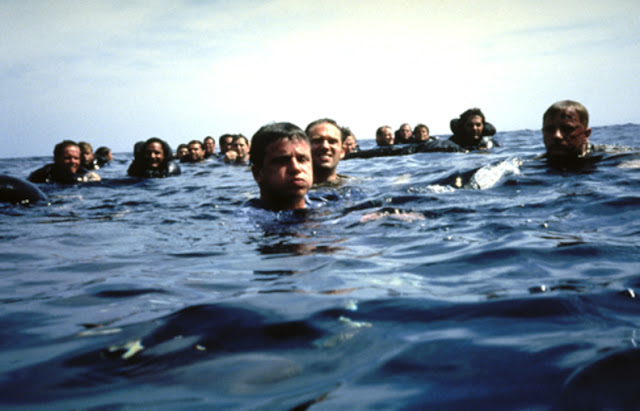On this date in History, both the Real World and Toobworld......
From Wikipedia:
After major repairs and an overhaul, Indianapolis received orders to proceed to Tinian island, carrying parts and the enriched uranium (about half of the world's supply of Uranium-235 at the time) for the atomic bomb Little Boy, which would later be dropped on Hiroshima. Indianapolis departed San Francisco on 16 July 1945, within hours of the Trinity test. Arriving at Pearl Harbor on 19 July, she raced on unaccompanied, delivering the atomic weapon components to Tinian on 26 July.Indianapolis was then sent to Guam where a number of the crew who had completed their tours of duty were replaced by other sailors. Leaving Guam on 28 July, she began sailing toward Leyte where her crew was to receive training before continuing on to Okinawa to join Vice Admiral Jesse B. Oldendorf's Task Force 95.
At 00:14 on 30 July, she was struck on her starboard bow by two Type 95 torpedoes from the Japanese submarine I-58, under the command of Mochitsura Hashimoto. The explosions caused massive damage. The Indianapolis took on a heavy list, and settled by the bow. Twelve minutes later, she rolled completely over, then her stern rose into the air, and she plunged down. Some 300 of the 1,196 crewmen went down with the ship. With few lifeboats and many without lifejackets, the remainder of the crew were set adrift.
Navy command had no knowledge of the ship's sinking until survivors were spotted three and a half days later. At 10:25 on 2 August aPV-1 Ventura flown by Lieutenant Wilbur "Chuck" Gwinn and copilot Lieutenant Warren Colwell spotted the men adrift while on a routine patrol flight. Of the 880 who survived the sinking, only 321 men came out of the water alive; 317 ultimately survived. They suffered from lack of food and water (some found rations such as Spam and crackers amongst the debris), exposure to the elements (hypothermia, dehydration, hypernatremia, photophobia, starvation and dementia), severe desquamation, and shark attacks, while some killed themselves or other survivors in various states of delirium and hallucinations. "Ocean of Fear", a 2007 episode of theDiscovery Channel TV documentary series Shark Week, states that the Indianapolis sinking resulted in the most shark attacks on humans in history, and attributes the attacks to the oceanic whitetip shark species. Tiger sharks might have also killed some sailors. The same show attributed most of the deaths on Indianapolis to exposure, salt poisoning and thirst, with the dead being dragged off by sharks.
Gwinn immediately dropped a life raft and a radio transmitter. All air and surface units capable of rescue operations were dispatched to the scene at once. A PBY Catalina seaplane under the command of Lieutenant R. Adrian Marks was dispatched to lend assistance and report. En route to the scene, Marks overflew USS Cecil J. Doyle and alerted her captain, future U.S. Secretary of the Navy W. Graham Claytor, Jr., of the emergency. On his own authority, Claytor decided to divert to the scene.
Arriving hours ahead of Doyle, Marks' crew began dropping rubber rafts and supplies. Having seen men being attacked by sharks, Marks disobeyed standing orders and landed on the open sea. He began taxiing to pick up the stragglers and lone swimmers who were at the greatest risk of shark attack. Learning the men were the crew of Indianapolis, he radioed the news, requesting immediate assistance. Doyle responded while en route. When Marks' plane was full, survivors were tied to the wings with parachute cord, damaging the wings so that the plane would never fly again and had to be sunk. Marks and his crew rescued 56 men that day.
The Doyle was the first vessel on the scene. Homing on Marks's Catalina in total darkness, Doyle halted to avoid killing or further injuring survivors, and began taking Marks' survivors aboard. Disregarding the safety of his own vessel, Captain Claytor pointed his largest searchlight into the night sky to serve as a beacon for other rescue vessels. This beacon was the first indication to most survivors that rescuers had arrived.
The destroyers Helm, Madison, and Ralph Talbot were ordered to the rescue scene from Ulithi, along with destroyer escorts Dufilho, Bassett, and Ringness of the Philippine Sea Frontier. They continued their search for survivors until 8 August.
And those events happened in the Cineverse as well, but the account of them were off.....
From Wikipedia:
Arguably the most well known fictional reference to the events occurs in the 1975 thriller film Jaws in a monologue by actor Robert Shaw, whose character Quint is depicted as a survivor of the Indianapolis sinking. The monologue emphasizes the numerous deaths caused by shark attacks after the sinking. John Milius was specifically brought into the production to write lines for this scene and he based them on survivor stories. However, there are several historical inaccuracies in the monologue: the speech states the date of the sinking as 29 June 1945, when the ship was actually sunk on 30 July, that they were spotted at noon of the fifth day rather than the third day, that 1,100 men went into the water and 316 came out (nearer 900 went in and 321 came out, of whom 317 survived) and that because of the secrecy of the atom bomb mission no distress call was broadcast, while declassified Navy documents prove the contrary.
It occurred in Toobworld as well: The incident itself was the subject of the 1991 made-for-television movie "Mission of the Shark: The Saga of the USS Indianapolis", with Stacy Keach portraying Captain Charles Butler McVay III.
This scene is dubbed into Spanish but it doesn't lessen the power of the acting if you don't speak the language....
The full movie is available on YouTube but embedding has been disabled. Click here to see it.
God bless the crew of the Indianapolis that fateful day 70 years ago today........




No comments:
Post a Comment